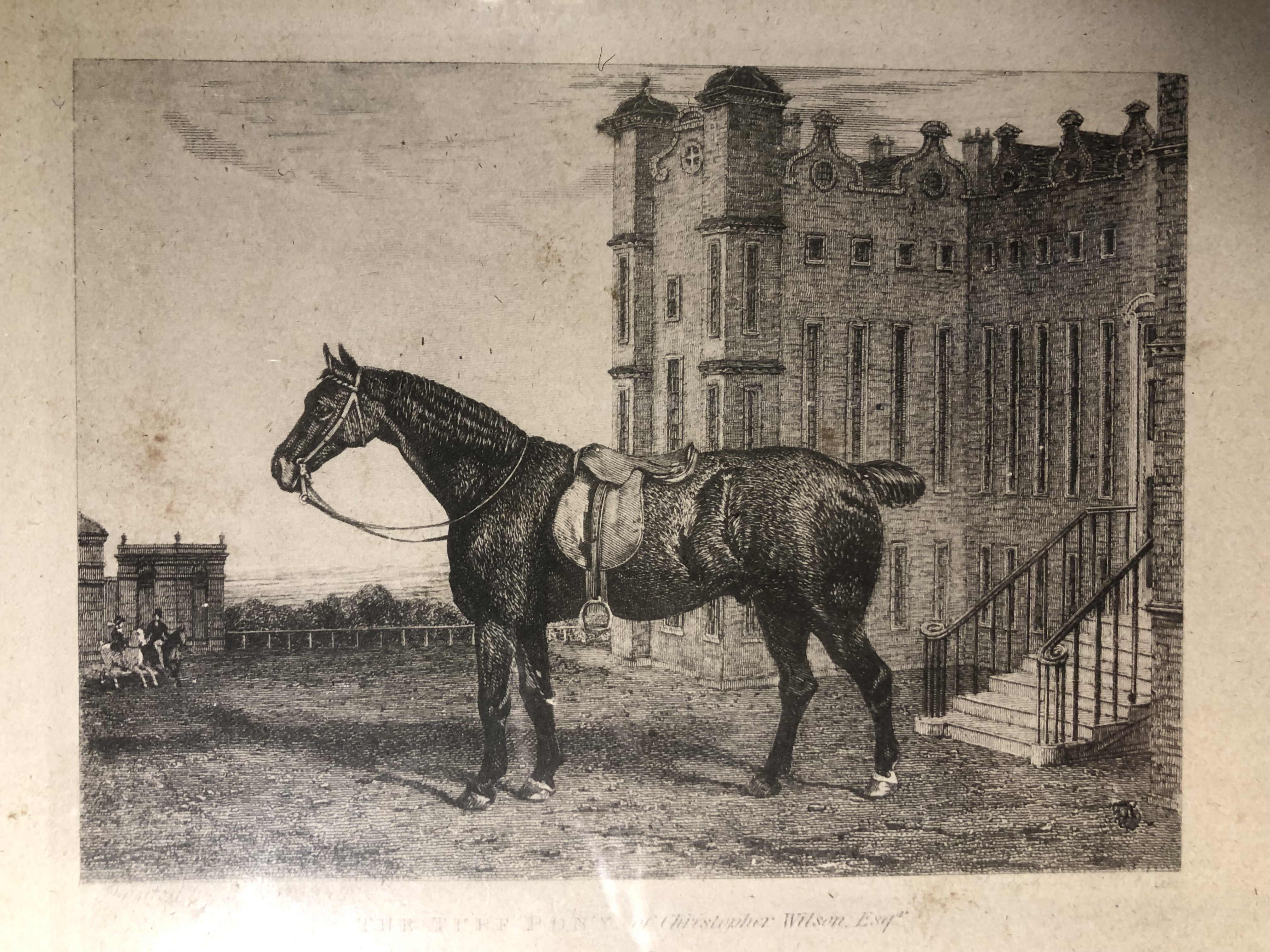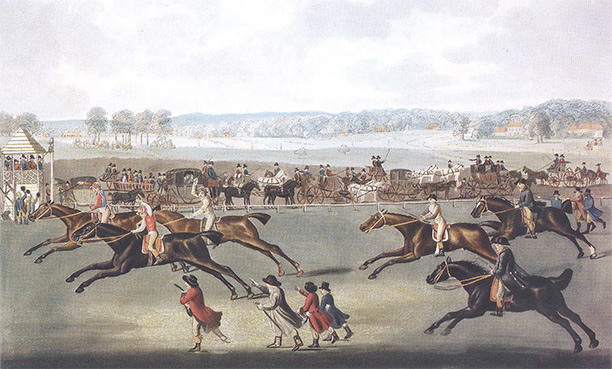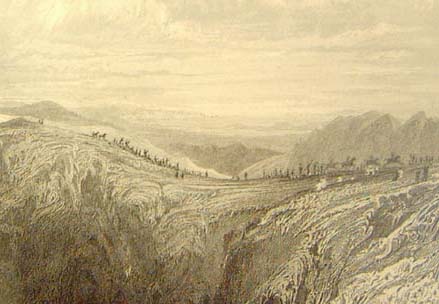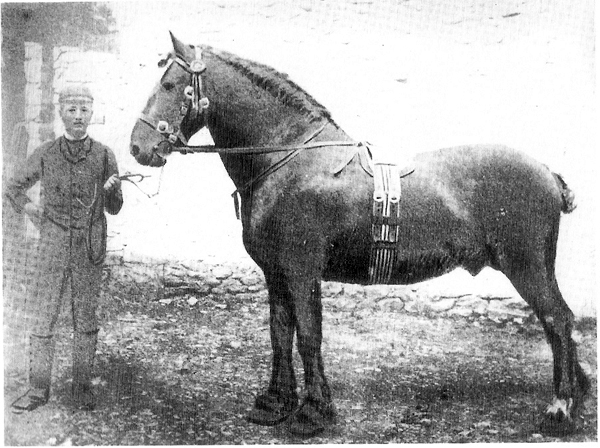Turf Ponies

The caption at the foot of the print reads: "THE
TURF PONY of Christopher Wilson, Esqr. Painted by L Marshall.
Engraved by E Babbage." The background is probably Ledston Hall,
West Yorkshire.
I bought this copy of the print on eBay after seeking the original for more than 10 years! The seller thought it must have come from an old "Sportsman" magazine, but he was not sure, and its size and the lack of text on the other side suggest it is a book plate. It is printed in two of Sir Walter Gilbey's books, "Ponies Past and Present", and "Thoroughbred and Other Ponies" (1903) in which the caption reads: "A Pony Hack: A pony well known on Newmarket Heath and North Country racecourses, about 1828."
The house (thanks to the detective work of Dr Nicola Toop of FAS Heritage, in January 2024) is Ledston Hall in West Yorkshire which was leased to Christopher Wilson around 1810. This also suggests the engraving is earlier than 1828, by which time Wilson had moved to Cumbria. The costumes of the two figures on horseback in the background may be Regency or William IV in date but they are so small it is difficult to be sure.
In 1822-23, Christopher Wilson, then living at Abbot Hall, Kendal, bought Rigmaden Park outside Kirkby Lonsdale. He commissioned the architect, George Webster, to design a new house built on the site of the "ancient manor house". "It is now a splendid mansion, standing upon a lofty eminence, which rises rapidly from the west side of the Lune, and commands a fine view of the vale." (Mannix).
Previously I and other people had assumed this picture was of Rigmaden, given the date applied by Gilbey, but it makes much more sense for the pony to be shown at a location in Yorkshire, where the Thoroughbred was developed and a "galloping grandstand" would be of use to a keen spectator, than in a part of Cumbria where there isn't much TB tradition.
 Painting of 1751 by
John Sartorius of the Oatlands Sweepstake at Ascot. The gentleman
on the right nearest the viewer, and the one on the bay with white
foot and star, are not racing but spectating.
Painting of 1751 by
John Sartorius of the Oatlands Sweepstake at Ascot. The gentleman
on the right nearest the viewer, and the one on the bay with white
foot and star, are not racing but spectating.
These turf ponies were seen at most race meetings before grandstands were built. Owners, spectators or press could take up a position "on the rails" (if they existed!) and gallop alongside the runners for part of the race. If they didn't have a horse they ran!
Turf ponies needed to be short and stocky to carry portly gents, but fast and enduring. They may have been a cross between a Thoroughbred or an Oriental breed and the local "Galloway" stock. North Country Galloways themselves were part of the foundation of the Thoroughbred. As can be seen, the racehorses were not much taller than the "turf ponies".
Shepherds' Meets

Shepherds would meet annually at some convenient point to exchange sheep which had "come astray". James Clarke visited a meet on the flat saddle-like summit of High Street in the 1780s:
"Neighbouring shepherds ... held festival, during which there were horse racing, wrestling and other such-like country diversions." Thomas Allom recorded a similar event in his print shown here (published by Son & Co in 1835). I photographed this print, by permission, at Kendal Library in 2000, when I first built the Fell Pony Museum site.
Riders were traditionally served bread and ale before they raced, and the winner got a barrel of beer. (Richardson)
The traditional date of the shepherds' meet on High Street was 10th July. According to Garnett it was held until about 1835.
Curiously, the local maps don't identify Racecourse Hill until the first Ordnance Survey in the 1850s.
Trotting Comet and his line
In the 1860s Tom Jones Evans of Craven Arms, Shropshire, brought his father Dafydd's brown (dark bay) Welsh cob stallion Trotting Comet up to compete against the trotting Fell ponies. Comet was foaled in 1851 and has been described both as "a heavy cob standing nearly 15 hands in height" and a "16-hand, dark bay". Trotting Comet was sired by an older Trotting Comet (834 HHSB); this older horse was "one of the founding fathers of Welsh Cobs" and was bred out of a mare named Black Bess, by Cauliflower. He was probably registration 1411 in the Hackney Horse Stud Book (Fitzgerald, 2000).
Trotting Comet (junior) had been bred by Ellis Thomas of the Talbot Hotel, Tregaron, and in the north he was known as Comet Talbot. He was responsible for producing "the Comets", a type of large, active roadster out of Galloway mares, which sold for good money at horse fairs such as Brough Hill.
Trotting Comet / Comet Talbot spent a winter at Orton in the care of a farmer named Bell, who lived at New House, (later known as The Kennels, of the Lunesdale Foxhounds; now reverted to New House). This is just down the road from Bousfield, Orton, where Comet himself was kept. The next year, Comet Talbot was matched against time over a very stiff course from Shap toll-bar to the top of the turnpike over Shap Fell, and back. He covered ten miles in 33 minutes carrying a 12 stone man. (Charlton)
Comet remained in Westmorland and was used on the local stock (Richardson).
 Comet II (Young Comet)
Comet II (Young Comet)
A portrait, a very large black and white photograph, hung in the house at Bousfield and was shown to a Fell Pony Society Council meeting by Bill Potter in 2013: "a rough looking, common headed cob; you would never think, to look at him, the speed he must have had." (P Metcalfe) There are pencil marks outlining the groom's clothing and the horse's legs where they had faded (the horse is not, as wrongly asserted in the American magazine 'Equus' in 2016, wearing any kind of boots! Given that photography was only in its infancy in the 1860s, the portrait photograph (sometimes said to be of Comet Talbot) is more likely to be a picture of his son Comet II or "young Comet". Certainly that is the caption on the copy of this photo in "Dales Ponies". He was said to have been out of a Galloway mare - in other words, he was a Welsh Cob/Hackney x Fell or Dales.
Comet II was bred by William Hully and could trot a mile in three minutes. William Hully bred used him to breed Hackney or trotting galloway types, and one of them, Daddy's Lad, was at stud at Great Musgrave near Kirkby Stephen for the season 1908, and later exported to Argentina. Mr Hully also bred Fells that won local show classes in Westmorland in 1903. The family has bred Dales ponies up to the present day.
Several Linnel Fell ponies traced back to Daddy's Lad, eg Linnel Boy and Linnel Lingcropper. R B Charlton (1952) remarked that Comet's descendants inherited his energy, soundness and stamina. However, there could be a down side to this bloodline, as some of "the Comet horses" were also known to be "a bit crackers". One ran away in harness into Orton with Bell's grandson at the reins; just outside the shop, it ran into the back of a wagon and killed itself.
Ironically, although the popularity of Comet II means that his line is found today in every registered Fell pony, it was the crossing of the native hill ponies with such Hackney types and with big draught breeds like the Clydesdale, to produce "trap horses" and "farm cobs", that led directly to the the Northern Fell Committee, and the Fell Pony Society, aiming "to foster and keep pure the old breed of pony."